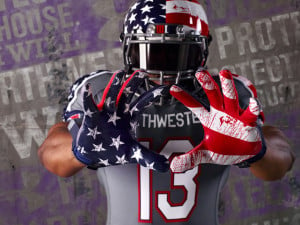
I assume the meeting that produced Northwestern’s Wounded Warrior Project jerseys went something like this: Our imaginary friends Bob the designer and Chad the executive are having a brainstorming session.
Bob: So I want to tear up an American flag and use it as side paneling. Cut it so it really accentuates the thighs on these athletes.
Chad: I like where you’re going. But what about the part in the U.S. flag code — this is where you know it’s fiction because they would never check — where it says, “No part of the flag should ever be used as a costume or athletic uniform?” (Title 4, § 8, (j))
Bob: I won’t hear it, and I won’t respond to it. All right, so then I figure we smother it all up in blood. I’m thinking, like, freshly gutted buck chic.
Chad: You’re a damn genius, Bob. If they get queasy, we’ll tell ‘em it’s ketchup.
Bob: What do you think we should give to charity? Five percent? Seven percent?
Chad: Bob, we give them a generous 10 percent and maybe they’ll star in a commercial to show how much we love America. But we gotta make sure to write it off on our taxes. Wouldn’t want any more of the proceeds accidentally ending up in the Department of Veterans Affairs.
Bob: Brilliant.
It’s difficult to criticize these things — this sort of “rah-rah” patriotism that serves more self-interest than it does soldiers. Rational minds will disagree with me that this is a problem. After all, doing something is better than doing nothing, which is what a large chunk of Americans elect to do when it comes to our military and veterans. But it’s part of a larger issue that arises when less than 1 percent serve at the political bidding of the other 99+ percent: a deepening civilian-military divide that’s becoming less about either side merely understanding each other and more about one side not even knowing the other exists.
Take, for instance, the Press, Pentagon and the Public class I’m in. An informal survey at the beginning of the quarter revealed roughly half of the class knew somebody in the military. Many fewer — I counted two of us — had immediate family members who served. And this was a self-selecting class of people interested in conflict, military and war reporting. I found the lack of exposure shocking.
A bit higher on the societal food chain, we saw politicians last month eager to wave their flags and break down memorial barricades for older vets and swarming cameras. At the same time, they deprived members of the Reserve Officers’ Training Corps at this university and at campuses across the country of a stipend check that helps these students pay for textbooks, food and housing. No cameras showed up for them, and even The Daily neglected to cover it.
None of this should be taken as a criticism of the Wounded Warrior Project itself, which does important, vital work that the public at large neglects to do. But perhaps NU can put its money where its mouth is and match — or double, or triple — the paltry 10 percent Under Armour is willing to part with on each jersey sale. Perhaps they can recycle some of that Post-9/11 GI Bill money they happily accept into sustainable programs for student veterans. Maybe they can do it in a way that connects them to the students on campus who have no experience with them.
It’s probably the least they can do for the roughly 1 million veterans who spilled actual blood in Afghanistan and Iraq so our football players can play dress-up as zombie members of SEAL Team 6 on Nov. 16.
Sean Lavery is a Medill senior. He can be reached at seanlavery2014@u.northwestern.edu. If you want to respond publicly to this column, send a Letter to the Editor to opinion@dailynorthwestern.com.














